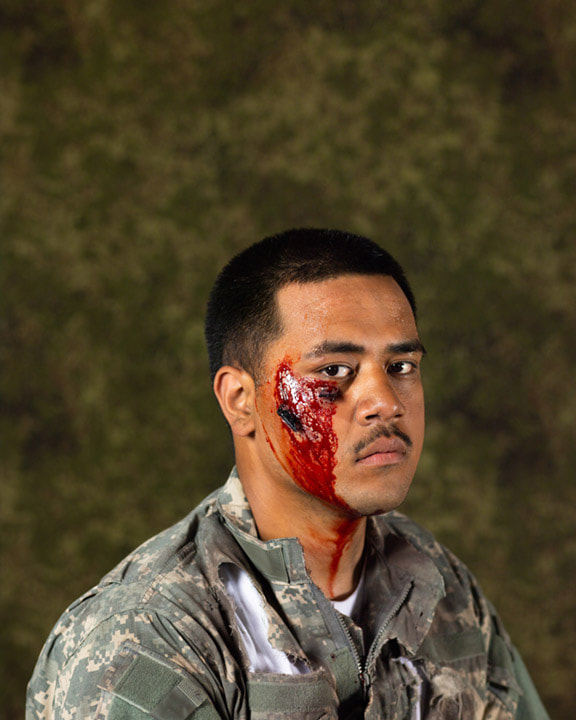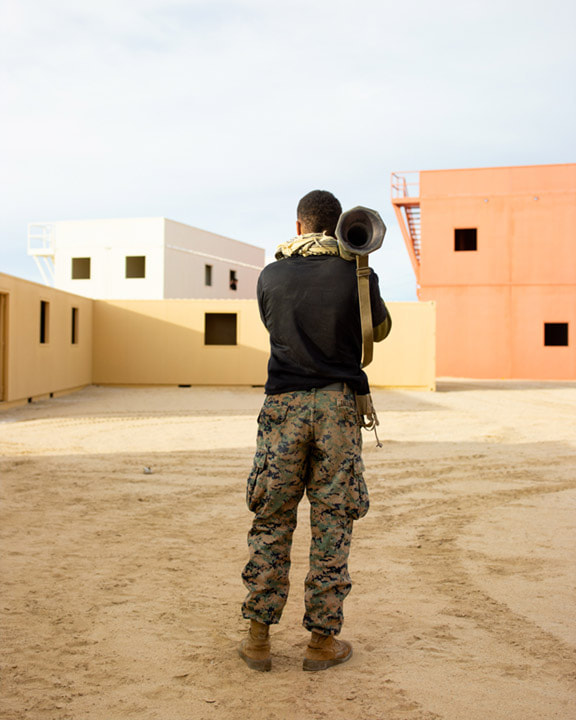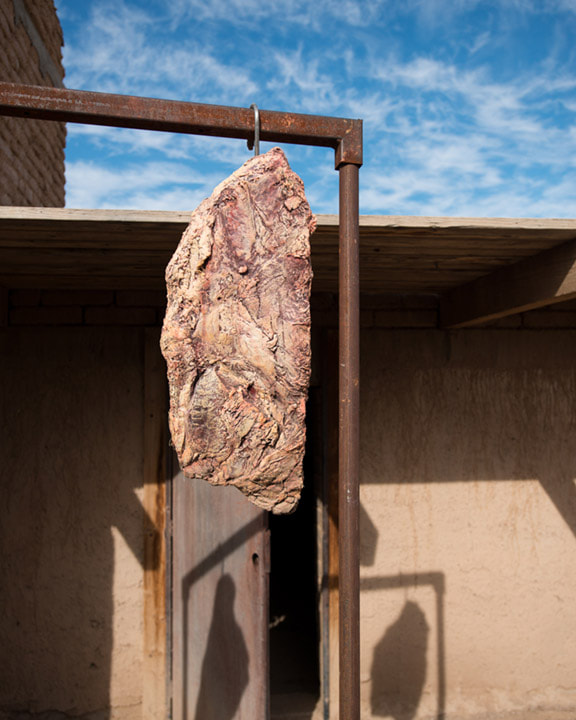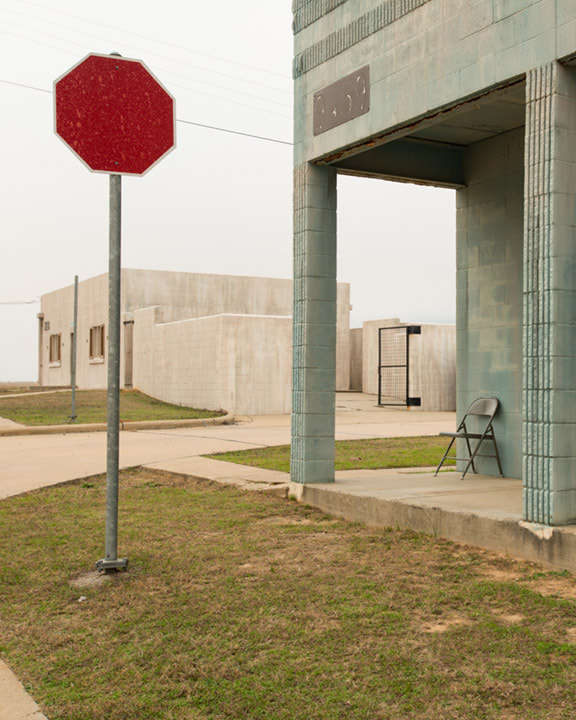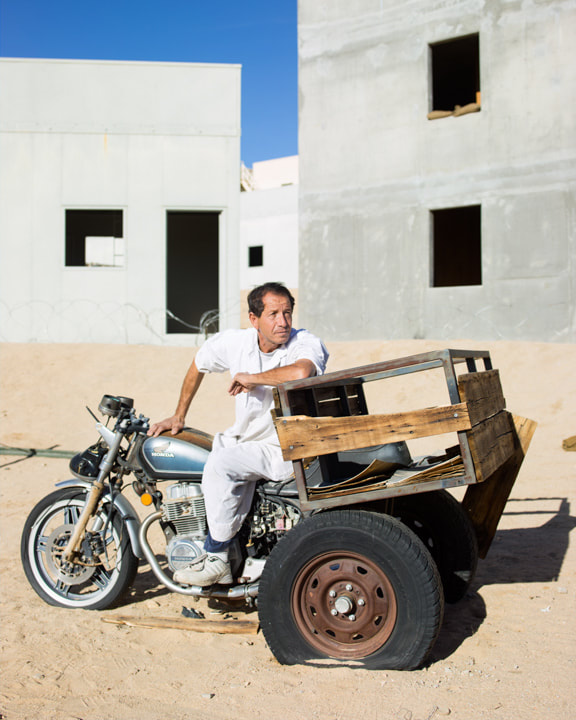This interview has been edited for length and clarity.
|
|
About the PhotographerDebi Cornwall is a conceptual documentary artist and filmmaker who returned to visual expression in 2014 after a 12-year career as a civil-rights lawyer. Marrying dark humor with structural critique, she employs still and moving images along with testimony and archival materials to examine state-created realities. While completing a degree in Modern Culture and Media at Brown University, she studied photography at RISD. After working for photographers Mary Ellen Mark and Sylvia Plachy, as an AP stringer, and as an investigator for the federal public defender's office, Cornwall attended Harvard Law School and practiced for more than a decade as a civil-rights attorney. Necessary Fictions (Radius Books), Cornwall's recent book on the staging and performance of American power in immersive, realistic military wargames, was nominated for the Deutsche Börse Photography Foundation Prize and shortlisted for the Rencontres de la Photographie d'Arles Photo-Text Book Award and the Lucie Photo Book Prize. |
|
What are the stories we are told, the games we play, to manage unsettling realities? Necessary Fictions explores the staging and performance of power in a militarized United States. Made on ten military sites over a four-year period, Necessary Fictions documents desert villages and their inhabitants in the fictional country of “Atropia.” Costumed Afghan and Iraqi civilians, many of whom have fled war, recreate it in the service of the U.S. military. American soldiers preparing to deploy are dressed by Hollywood makeup artists in “moulage”—fake wounds—during immersive realistic training scenarios, dress rehearsals for their possible futures as casualties of war.
Truth in Photography: What motivated you to start doing these kinds of photographs?
Debi Cornwall: The Necessary Fictions series really grew out of my experience at Guantanamo Bay for my first project, Welcome to Camp America. I spent very long days in the company of military escorts, asking them about their lives as we went from site to site, and I was struck at how their deployments had affected them and continued to affect them. No one was sleeping through the night. I became interested in two things. One, the way Guantanamo was set up as a staged-managed reality for public consumption. And then, spending all this time with my escorts, I started thinking about how they wrapped their heads around the gravity and enormity of waging war. So, as that project was with the publisher, I started doing some research and came across this phenomenon of immersive, realistic military training scenarios. When I delved a little deeper, I realized that this phenomenon is at the intersection of a number of things that interest me.
TiP: When did you start doing this series?
Cornwall: I think my first trip to shoot was in the fall of 2016, and I was making pictures for about three years. I had to negotiate access with the Army and the Marines and then with each specific site that I wanted to visit. So that was a big part of the process.
TiP: In making these photographs, what do you hope is the takeaway when people see them?
Cornwall: Generally my work is about posing questions more than answering them. There's the literal: here are things happening in a place. But I'm really interested in how fictions are deployed and embraced in contemporary American life. What happens when fact and fiction bleed into one another, when we take refuge in fictions from unsettling realities? I'm using the pictures as a jumping off point to ask questions that aren't necessarily about the military, or war, at all.
TiP: Complete the sentence, “Truth in photography is…”
Cornwall: “In the eye of the beholder” is what first comes to mind. It's really tricky in an era awash with images, awash with disinformation, awash with propaganda. My practice started in a social documentary vein when I was in college and taking classes at Rhode Island School of Design in the ’90s, working for people like Mary Ellen Mark. Over time, I came to talk myself out of that approach. Not because of the truth value of social documentary so much as the different perspectives offered by someone in my position, a white American woman, versus the kinds of pictures that my protagonists might make of themselves, for themselves. My senior year in college, my thesis was looking at that in the context of Narragansett Indians, Native Americans in Rhode Island. By the end of the thesis, I had decided, there's the Edward Curtis staged portraits of Native Americans that are so well known and so constructed, and there's me coming in and looking at these pow-wows and making portraits of Native Americans at home. And then look at the pictures these citizens are making of their own lives. What’s more truthful? What's more authentic? At the time I decided it's not appropriate for me to make these pictures. The most authentic, truthful images are those that my subjects are making of themselves and for themselves. I took a long break from photography, which turned into a career in civil-rights law. And since I returned to a visual practice in 2014, my practice has sought to illuminate the way power operates, to look systemically at the way power is staged and performed, as a way to peel away layers of untruths. I look at fictions as a way to illuminate truth.
TiP: Can fiction lead to a deeper truth?
Cornwall: Yes. I'm actually teaching a class at the ICP called “Necessary Fictions,” in which we survey ways in which photographers, filmmakers, writers, and visual artists use fictions as a way to illuminate truths. We're surrounded by deeply unsettling realities. It can be really hard to look at that war picture, that injured person, that suffering person. If we look at the fictional version, it's almost safer to let in the truth.
There’s a part of the Necessary Fictions military training scenarios where American soldiers are dressed by Hollywood makeup artists, in between movie gigs, dressed up as though the soldiers were mortally wounded. The reality of what happens to American soldiers can be very sensitive for Americans. So on my way out to Santa Fe to meet with my publisher on the book, I had to pass through the Dallas/Fort Worth airport and I realized I should just take the pulse of regular people to see how the pictures would land. I started walking up to random strangers and saying, “I'm a photographer, I'm making pictures of American soldiers. I wonder if you have a minute to take a look and tell me what, if anything, comes up for you?” And it was so interesting. Anecdotally, it broke down almost exactly by gender and veteran status. Some people looked at the pictures, men, and said, “That's fake,” and handed them back, and that was the end of the conversation. The first person I talked to was a man with a gray ponytail and a “Veterans for Trump” t-shirt. And he said, “I see the horrors of war. This is real.” And then he told me about his service. I got that answer multiple times from all of the women as well (again, anecdotally), and people said, “This is what we don't see. The realities of war.” And some became quite emotional. It seems as though some of us are primed to review fictions as a window into an emotional truth.
Debi Cornwall: The Necessary Fictions series really grew out of my experience at Guantanamo Bay for my first project, Welcome to Camp America. I spent very long days in the company of military escorts, asking them about their lives as we went from site to site, and I was struck at how their deployments had affected them and continued to affect them. No one was sleeping through the night. I became interested in two things. One, the way Guantanamo was set up as a staged-managed reality for public consumption. And then, spending all this time with my escorts, I started thinking about how they wrapped their heads around the gravity and enormity of waging war. So, as that project was with the publisher, I started doing some research and came across this phenomenon of immersive, realistic military training scenarios. When I delved a little deeper, I realized that this phenomenon is at the intersection of a number of things that interest me.
TiP: When did you start doing this series?
Cornwall: I think my first trip to shoot was in the fall of 2016, and I was making pictures for about three years. I had to negotiate access with the Army and the Marines and then with each specific site that I wanted to visit. So that was a big part of the process.
TiP: In making these photographs, what do you hope is the takeaway when people see them?
Cornwall: Generally my work is about posing questions more than answering them. There's the literal: here are things happening in a place. But I'm really interested in how fictions are deployed and embraced in contemporary American life. What happens when fact and fiction bleed into one another, when we take refuge in fictions from unsettling realities? I'm using the pictures as a jumping off point to ask questions that aren't necessarily about the military, or war, at all.
TiP: Complete the sentence, “Truth in photography is…”
Cornwall: “In the eye of the beholder” is what first comes to mind. It's really tricky in an era awash with images, awash with disinformation, awash with propaganda. My practice started in a social documentary vein when I was in college and taking classes at Rhode Island School of Design in the ’90s, working for people like Mary Ellen Mark. Over time, I came to talk myself out of that approach. Not because of the truth value of social documentary so much as the different perspectives offered by someone in my position, a white American woman, versus the kinds of pictures that my protagonists might make of themselves, for themselves. My senior year in college, my thesis was looking at that in the context of Narragansett Indians, Native Americans in Rhode Island. By the end of the thesis, I had decided, there's the Edward Curtis staged portraits of Native Americans that are so well known and so constructed, and there's me coming in and looking at these pow-wows and making portraits of Native Americans at home. And then look at the pictures these citizens are making of their own lives. What’s more truthful? What's more authentic? At the time I decided it's not appropriate for me to make these pictures. The most authentic, truthful images are those that my subjects are making of themselves and for themselves. I took a long break from photography, which turned into a career in civil-rights law. And since I returned to a visual practice in 2014, my practice has sought to illuminate the way power operates, to look systemically at the way power is staged and performed, as a way to peel away layers of untruths. I look at fictions as a way to illuminate truth.
TiP: Can fiction lead to a deeper truth?
Cornwall: Yes. I'm actually teaching a class at the ICP called “Necessary Fictions,” in which we survey ways in which photographers, filmmakers, writers, and visual artists use fictions as a way to illuminate truths. We're surrounded by deeply unsettling realities. It can be really hard to look at that war picture, that injured person, that suffering person. If we look at the fictional version, it's almost safer to let in the truth.
There’s a part of the Necessary Fictions military training scenarios where American soldiers are dressed by Hollywood makeup artists, in between movie gigs, dressed up as though the soldiers were mortally wounded. The reality of what happens to American soldiers can be very sensitive for Americans. So on my way out to Santa Fe to meet with my publisher on the book, I had to pass through the Dallas/Fort Worth airport and I realized I should just take the pulse of regular people to see how the pictures would land. I started walking up to random strangers and saying, “I'm a photographer, I'm making pictures of American soldiers. I wonder if you have a minute to take a look and tell me what, if anything, comes up for you?” And it was so interesting. Anecdotally, it broke down almost exactly by gender and veteran status. Some people looked at the pictures, men, and said, “That's fake,” and handed them back, and that was the end of the conversation. The first person I talked to was a man with a gray ponytail and a “Veterans for Trump” t-shirt. And he said, “I see the horrors of war. This is real.” And then he told me about his service. I got that answer multiple times from all of the women as well (again, anecdotally), and people said, “This is what we don't see. The realities of war.” And some became quite emotional. It seems as though some of us are primed to review fictions as a window into an emotional truth.
TiP: Ultimately, what makes us believe someone's telling the truth is the way they contextualize themselves, so that it becomes believable. I think that's true in photography as well.
Cornwall: I was just giving this talk in the Emirates about my work and afterwards spoke to a Russian photojournalist, who said, “I see what you're doing. Most of us photojournalists are looking for an emotional moment that will bring viewers into the emotional reality of the moment, that will sum it up, but you're using photographs like evidence to tell a different kind of story.” And I hadn’t thought about it so much that way, but it makes sense.
TiP: That's a very interesting subject. What's the difference? What is evidence?
Cornwall: In the context of what he was talking about, my work on Guantanamo, he was commenting on the way in which I'm looking at different elements of a system and creating a context to understand how that system works, especially if it's a system that works invisibly. It's not about the emotional moments, you know? It's about illuminating systems of power that otherwise might go unseen.
TiP: How do you feel your photographs of these exercises that people are doing convey the emotional side? Is there an emotional truth that you're looking for? Or are the people just going through the motions of doing what they're supposed to do and trying to tamp down their emotions?
Cornwall: With the moulage photographs in particular, you see a range of reactions. Some of the soldiers said, “Oh, this is just a joke to me.” Or “Let me do a smiling one for my mom or my girlfriend,” but I wasn't going to take that picture, until someone asked. There was something really jarring to me about the disconnect between an apparently gravely wounded soldier with a smile on his face as though he's sitting for a class picture, or an extra in a zombie movie. I asked each of the soldiers in moulage how it felt for them to be dressed this way as they prepared to get on airplanes and go wage war and there was just a huge range. For one or two of them, it was a big joke. And you could see this emotional distancing from contemplating the reality that might lie ahead for them. And others said, “I come from a family in the service, and this is my job.” And there was one young man who did not answer me. I kept making pictures, and finally, it felt like five minutes later, all he said to me was, “I just got married.”
The expressions of the moulaged soldiers, and their reactions, offer a window into their emotional experience. It raises the question, What’s the saner relationship to this reality, or to this performance that is the proxy for the reality? Is it saner to let in the reality that you might die and leave your new wife a widow? Or is it saner to pretend it's all a joke and emotionally distance yourself and not let in the sobering possibility of how this might go?
Cornwall: I was just giving this talk in the Emirates about my work and afterwards spoke to a Russian photojournalist, who said, “I see what you're doing. Most of us photojournalists are looking for an emotional moment that will bring viewers into the emotional reality of the moment, that will sum it up, but you're using photographs like evidence to tell a different kind of story.” And I hadn’t thought about it so much that way, but it makes sense.
TiP: That's a very interesting subject. What's the difference? What is evidence?
Cornwall: In the context of what he was talking about, my work on Guantanamo, he was commenting on the way in which I'm looking at different elements of a system and creating a context to understand how that system works, especially if it's a system that works invisibly. It's not about the emotional moments, you know? It's about illuminating systems of power that otherwise might go unseen.
TiP: How do you feel your photographs of these exercises that people are doing convey the emotional side? Is there an emotional truth that you're looking for? Or are the people just going through the motions of doing what they're supposed to do and trying to tamp down their emotions?
Cornwall: With the moulage photographs in particular, you see a range of reactions. Some of the soldiers said, “Oh, this is just a joke to me.” Or “Let me do a smiling one for my mom or my girlfriend,” but I wasn't going to take that picture, until someone asked. There was something really jarring to me about the disconnect between an apparently gravely wounded soldier with a smile on his face as though he's sitting for a class picture, or an extra in a zombie movie. I asked each of the soldiers in moulage how it felt for them to be dressed this way as they prepared to get on airplanes and go wage war and there was just a huge range. For one or two of them, it was a big joke. And you could see this emotional distancing from contemplating the reality that might lie ahead for them. And others said, “I come from a family in the service, and this is my job.” And there was one young man who did not answer me. I kept making pictures, and finally, it felt like five minutes later, all he said to me was, “I just got married.”
The expressions of the moulaged soldiers, and their reactions, offer a window into their emotional experience. It raises the question, What’s the saner relationship to this reality, or to this performance that is the proxy for the reality? Is it saner to let in the reality that you might die and leave your new wife a widow? Or is it saner to pretend it's all a joke and emotionally distance yourself and not let in the sobering possibility of how this might go?
TiP: How is this communicated through your photographs, or alluded to? Talk about the way in which you light these, the framing of them.
Cornwall: My book designer and editor, David Chickey, and I thought long and hard about which pictures to include in the book. Did I want it to look like photojournalism, where I'm running around after people in the middle of scenarios, people shooting at each other? I have those pictures. Or did I want to focus on the formally composed, obviously staged images, with candy-colored hues and reflected desert light? In the end, I decided it's not a “Where's Waldo” tempting the reader to ask if we are really in Afghanistan. I decided I wanted to highlight the staged quality of the picture, as a message, as a commentary on the games as staged and performed. So the formal poses, composition, and lighting in the mobile portrait studio were an important part of that choice. These are people performing roles. They're not caught in the midst of a war. The way in which the picture is made should call attention to the constructed nature of the environment.
TiP: In terms of the way in which these environments are created, they create a certain sense of space and spatial relationship between people, buildings. Did you talk to the people who design these environments?
Cornwall: You know, I did not. That is one thing I did not do. I researched the companies that did it and some of the designs. There was nobody at the sites who was involved in the construction when I was there, but they are contractors, like everyone else in these environments. There are contractors who provide role players, there are contractors who provide scripts for scenarios, there are contractors who provide explosive effects, there are contractors who provide props. It's a big business creating these mock environments.
Cornwall: My book designer and editor, David Chickey, and I thought long and hard about which pictures to include in the book. Did I want it to look like photojournalism, where I'm running around after people in the middle of scenarios, people shooting at each other? I have those pictures. Or did I want to focus on the formally composed, obviously staged images, with candy-colored hues and reflected desert light? In the end, I decided it's not a “Where's Waldo” tempting the reader to ask if we are really in Afghanistan. I decided I wanted to highlight the staged quality of the picture, as a message, as a commentary on the games as staged and performed. So the formal poses, composition, and lighting in the mobile portrait studio were an important part of that choice. These are people performing roles. They're not caught in the midst of a war. The way in which the picture is made should call attention to the constructed nature of the environment.
TiP: In terms of the way in which these environments are created, they create a certain sense of space and spatial relationship between people, buildings. Did you talk to the people who design these environments?
Cornwall: You know, I did not. That is one thing I did not do. I researched the companies that did it and some of the designs. There was nobody at the sites who was involved in the construction when I was there, but they are contractors, like everyone else in these environments. There are contractors who provide role players, there are contractors who provide scripts for scenarios, there are contractors who provide explosive effects, there are contractors who provide props. It's a big business creating these mock environments.
TiP: Where does your title of this, Necessary Fictions, come from?
Cornwall: It's kind of a provocation. How much of this is really necessary? We are told that it's necessary, that realistic immersive training exercises will help save lives. But the underlying presumption, that we're always going to be at war, is never up for debate.
TiP: Do you have any other thoughts about this series of yours?
Cornwall: I guess just a plug for readers to look at the photographs in the context of my book with Radius, which is organized loosely in the model of a State Department report: with a location, the population, the resources, and text running throughout, much of which I have written and also gathered and collected of interactions with the role players. My own experiences, advertisements, news clippings, statistics about the wars, really a wide variety of textual sources that provide a different frame for the photographs of the games themselves.
Cornwall: It's kind of a provocation. How much of this is really necessary? We are told that it's necessary, that realistic immersive training exercises will help save lives. But the underlying presumption, that we're always going to be at war, is never up for debate.
TiP: Do you have any other thoughts about this series of yours?
Cornwall: I guess just a plug for readers to look at the photographs in the context of my book with Radius, which is organized loosely in the model of a State Department report: with a location, the population, the resources, and text running throughout, much of which I have written and also gathered and collected of interactions with the role players. My own experiences, advertisements, news clippings, statistics about the wars, really a wide variety of textual sources that provide a different frame for the photographs of the games themselves.
|
|
Excerpt from Necessary Fictions Romeo wants to make a portrait by the broken-down cart in the central roundabout. He strikes one pose, then another. He is practiced at this. When I ask, he shows me his SAG card. He’s a member of the Screen Actors’ Guild. He recites a list of films he has appeared in, but says he’s more excited now about his screenplay. Worn, folded pages appear from within the folds of his dishdasha and he invites me to read. It’s a treatment for a war thriller set in Iraq. He has a backer in Dubai, he says. It’s going to be big. He just needs to get it into the right hands. Do I happen to know anyone in Hollywood? |
|
|
Cornwall: To me, that quote is one more layer of the meta, how this Iraqi naturalized American citizen is working as a cultural role player and really leaning into fiction as his way forward as an American, as his way to make it. Hollywood is the way to go. He’s telling versions of his life, or enacting versions of his life, for the consumption of the American military, or an American audience.
|
|
|




